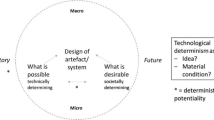Abstract
Educational systems always derive from cultural anticipations as well as expectations. There are abundant differences between Eastern and Western educational systems for they share a different culture which can reflects the pros and cons of themselves. Culture can also decide which parts of mankind activities are considered as the expressions of creativity. Are there any same meanings of Eastern and Western creativity for the pedagogy? How should we understand the word “creativity”? In eastern countries, especially the mainland China, what is the creativity in the current pedagogy? Countless researchers have put forward such questions by numerous different methods, and they have offered me sufficient hints figuring the creativity under different circumstance, such as mainland China, America and so on. I make a comparison among them and figure out the Chinese traits in the arts pedagogy in mainland China.
Similar content being viewed by others
Notes
Big “C” creativity = socially valued creativity
Little “c” = valued at the individual level.
References
Blacking, J.: How Musical is Man?. University of Washington Press, Seattle (1973)
Bradshaw, M., Ellison, C.G., Fang, Q., Mueller, C.: Listening to religious music and mental health in later life. Gerontologist 55(6), 961–971 (2015)
Brand, M.: Collectivistic versus Individualistic cultures: a comparison of American, Australian and Chinese music education students’ self-esteem. Music Educ Res 6(1), 57–65 (2004)
Bresler, L. (ed.): International Handbook of Research in Arts Education. Springer, Dordrecht (2007)
Burnett, C., Francisco, J.: Role of Intuition in Creativity. Encyclopedia of Creativity, Invention, Innovation and Entrepreneurship. Springer, New York (2013)
Zheng, C.: Guanyu guzheng lishi de tantao [The Discussion About the History of Guzheng]. Chinese Instrument Association, Beijing (1981)
Chiu, C.Y., Kwan, L.Y.Y.: Culture and creativity: a process model. Manag Org Rev 6(3), 447–461 (2010)
Ng, C. (ed.): Creativity: When East Meets West. World Scientific, River Edge (2004)
Hoondert, M.J.M.: Performances of religious music in Medieval and Late Modern Culture: introduction. Jaarboek voor Liturgie-onderzoek 29(2013), 47–48 (2013)
Kang, G.: Taijiquan de wenhua neihan he taiji yundongguan [The Culture Meaning and Athletic View in Taichi]. Handan College Journal, Han Dan (2008)
Kim, K.H., Pierce, R.A.: Creativity and Confucianism. Springer, New York (2013)
Koh, A.T.: Linking learning, knowledge creation, and business creativity: a preliminary assessment of the East Asian quest for creativity. Technol Forecast Soc Change 64(1), 85–100 (2000)
Lan, L., Kaufman, J.C.: American and Chinese similarities and differences in defining and valuing creative products. J. Creat. Behav. 46(4), 285–306 (2012)
Liu, L.: Yuanyu xin zhiyu hua—zhongxifang huajia chuangzuo qinggan biaoda fangshi bidui [From the Heart, to the Painting—The Comparison Between Eastern and Western in Expressing Ways of Emotional Creation]. Shanxi Teachers University, Shan Xi (2013)
Lubart, T.I.: Creativity and cross-cultural variation. Int. J. Psychol. 25(1), 39–59 (1990)
Maxwell, B.: Imitation, imagination and reappraisal: education the moral emotions. Chin. J. Moral Educ. 34(3), 291–307 (2007)
Ng, A.K.: Why Asians are Less Creative than Westerners. Prentice Hall, Singapore (2001)
Niu, W., Kaufman, J.C.: Creativity of Chinese and American cultures: a synthetic analysis. J. Creat. Behav. 47, 77–87 (2013)
Niu, W., Sternberg, R.J.: The philosophical roots of western and eastern conceptions of creativity. J. Theor. Philos. Psychol. 26(1–2), 18–38 (2006)
Runco, M.A., Jaeger, G.J.: The standard definition of creativity. Creat. Res. J. 24(1), 92–96 (2012)
Schieman, S.: Socioeconomic status and beliefs about god’s influence in everyday life. Sociol. Relig. 71(1), 25–51 (2010)
Sefton-Green, J., Thomson, P., Jones, K., Bresler, L. (eds.): The Routledge International Handbook of Creative Learning. Routledge, London (2011)
Simonton, D.K., Ting, S.S.: Creativity in Eastern and Western civilizations: the lessons of historiometry. Manag. Org. Rev. 6(3), 329–350 (2010)
Stierand, M., Dörfler, V.: Researching Intuition in Personal Creativity. Edward Elgar, Cheltenham (2014)
Styhre, A., Sundgren, M.: Intuition and creativity. In Managing Creativity in Organizations. Palgrave Macmillan, Basingstoke (2005)
Wang, B., Greenwood, K.M.: Chinese students’ perceptions of their creativity and their perceptions of western students’ creativity. Educ. Psychol. 33(5), 628–643 (2013)
Weiner, R.P.: Creativity and Beyond: Cultures, Values, and Change. SUNY Press, Albany (2012)
Wonder, J., Blake, J.: Creativity east and west: intuition vs. logic? J. Creat. Behav. 26(3), 172–185 (1993)
Xiao-Hu, L.I., Cheng, H.X.: Analysis of Confucianism “yue he” in Chinese music. J. Huaihua Univ. (2010)
Yu, J.: The Influence of Renaissance and Religious Reform on the Development of Music and Art Style. Atlantis Press, Amsterdam (2016)
Zhou, J., Su, Y.: A missing piece of the puzzle: the organization context in cultural patterns of creativity. Manag. Org. Rev. 6(3), 391–413 (2010)
Author information
Authors and Affiliations
Corresponding author
Rights and permissions
About this article
Cite this article
Junting, C., Arunkumar, N. Quantified comparative analysis of innovation and innovation based on multi orientation from the perspective of education and culture. Cluster Comput 22 (Suppl 2), 4711–4718 (2019). https://doi.org/10.1007/s10586-018-2317-6
Received:
Revised:
Accepted:
Published:
Issue Date:
DOI: https://doi.org/10.1007/s10586-018-2317-6




